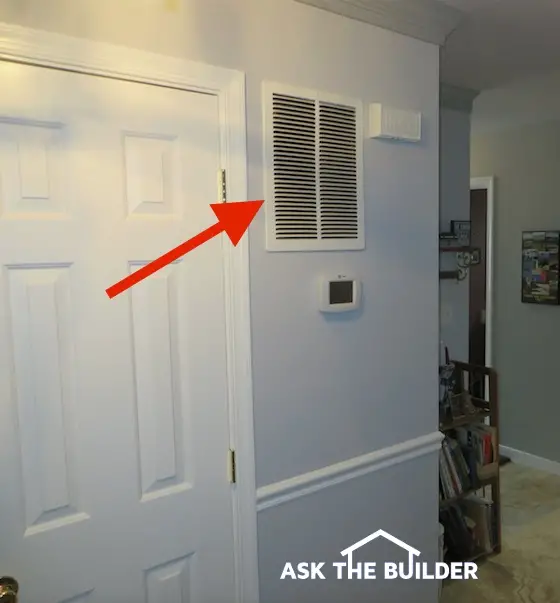There are a few schools of thought when it comes to wall vents and which way they should face – up or down. Some believe that wall vents should point up so that the warm air will rise and circulate throughout the room. Others believe that wall vents should point down so that the cold air will be drawn in and push the warm air out.
So, which is it?
There’s no right or wrong answer when it comes to wall vents – they can be installed pointing up or down, depending on your preference. Some people believe that wall vents should be installed pointing down so that the warm air from the heater will rise and circulate throughout the room. Others believe that wall vents should be installed pointing up so that the cool air from the air conditioner will be pulled down and circulate throughout the room.
Ultimately, it’s up to you to decide which way you want your wall vents to be installed.
WALL VENTS: remove them? Reduce draughts and save energy.
Should air vents point towards window
There’s no definitive answer to this question – it depends on a number of factors, including the size and layout of your room, the type of air vents you’re using, and your personal preferences.
If you have a small room, for example, pointing your air vents towards the window may help to circulate air more effectively. Alternatively, if you’re using floor vents, you may find that pointing them towards the window helps to keep your room cooler in the summer months.
ultimately, it’s up to you to experiment and see what works best for your space.
Vent direction
Assuming you would like a blog post discussing the importance of proper vent direction:
Have you ever noticed how some rooms in your home always seem stuffy and stagnant, no matter how often you open the windows or run the ceiling fan? It could be that your vents are not blowing air in the right direction.
You see, your vents should be blowing air downwards in order to effectively circulate the air in your home. If the vents are blowing air upwards, the air will get stuck near the ceiling and will have a harder time making its way around the room.
There are a few things you can do to make sure your vents are blowing air in the right direction.
First, take a look at your vents and see which way the air is blowing. If it is blowing upwards, you can try adjusting the slats on the vent so that they are pointing downwards.
Another thing you can do is to get some heavy duty magnets and attach them to the vents.
This will help to keep the vents in place and pointing in the right direction.
Vents that are properly directed can make a big difference in the air quality of your home, so it is definitely worth taking the time to make sure they are blowing air in the right direction.
Should return air vents face up or down
When it comes to return air vents, there is no definitive answer as to whether they should face up or down. It really depends on a number of factors, including the layout of your home, the type of heating and cooling system you have, and your personal preferences.
If you have a forced air heating and cooling system, the return vents play a crucial role in circulating air throughout your home.
If the vents are facing down, the air will naturally flow up and into the ductwork. This can help to improve the efficiency of your system and prevent hot and cold spots in your home.
However, if you have a gravity-fed system, or if you simply prefer the look of vents that face up, there’s no harm in installing them that way.
Ultimately, it’s up to you and what works best for your home.
Should heat vents point up or down
There’s no definitive answer to this question – it depends on your individual heating needs. If you have a large, open space that you need to heat, then pointing the vents up may be the best option. This will help to circulate the heat evenly throughout the room.
However, if you have a smaller space that you’re trying to heat, then pointing the vents down may be a better option. This will help to concentrate the heat in one area, making it more effective at warming the space. Ultimately, it’s up to you to decide which option is best for your needs.

Credit: www.askthebuilder.com
Top 10 Best Downdraft Vent Range Hood Reviews In 2022
Which way do Wall vents point?
Most people don’t think about which way their wall vents point, but it actually makes a big difference in how well your HVAC system works. If your vents are pointing the wrong way, you could be wasting a lot of energy and money.
Here’s a quick rundown of the proper way to point your wall vents:
In the winter, you want the vents to be pointing downwards so that the warm air stays in the room. In the summer, you want the vents to be pointing upwards so that the cool air stays in the room.
If your vents are pointing in the wrong direction, simply adjust them so that they’re pointing in the right direction.
It’s a quick and easy fix that can make a big difference in your home’s comfort level.
Which way should air vents face?
There are a few considerations to take into account when deciding which way air vents should face in a home. The first is the direction of the prevailing winds. If the winds are blowing from the north, then it would make sense to have the air vents face the south.
This would help to ensure that the air being blown into the home is coming from a direction that is not being obstructed by the house itself. The second consideration is the sun. If the air vents are facing the sun, then they will be less likely to collect dust and other particles.
The third consideration is the location of the air vents. If they are located near a source of noise, then it would make sense to have them face away from the source of the noise. This would help to reduce the amount of noise that is coming into the home.
Do cold air return vents go up or down?
Most people think that cold air return vents should go up. After all, cold air is heavier than warm air, so it should sink, right? Wrong.
Your cold air return vent should actually be installed at the lowest point in your room. That’s because the cold air is pulled into the vent by the furnace, and then circulated back up into the room.
If you have a cold air return vent that’s installed high up on the wall, the cold air will just circulate around the room and never actually make it back to the furnace.
This can cause your furnace to work harder than it needs to, and ultimately shorten its lifespan.
So if you’re wondering whether cold air return vents go up or down, the answer is down. Install your cold air return vent at the lowest point in the room, and you’ll enjoy more efficient heating (and a longer-lasting furnace).
Conclusion
There are a few schools of thought on this one, but the main argument for vents pointing up is that it prevents cold air from coming into the home. The logic behind this is that heat rises, so cold air will be trapped at the bottom of the vent if it’s pointing down. Some people argue that vents should point down because it helps to circulate the air in the home, but this isn’t necessarily true.
If the vents are pointing up, the air will still circulate, it will just take a little longer. Ultimately, it’s up to the homeowner to decide which way they want their vents to point.

